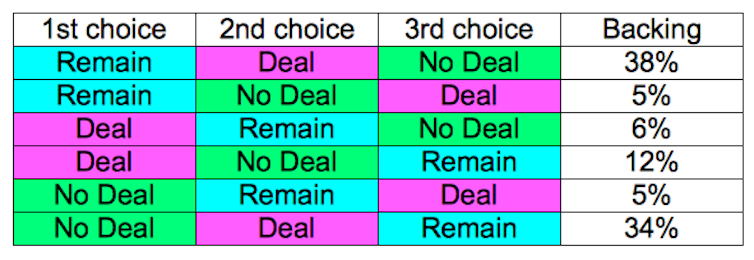Should there be a second referendum on Brexit? Those in favour seem to be growing in number. The People’s Vote, led by respective Labour and Tory dissidents Chuka Umunna and Anna Soubry, is campaigning for any final Brexit deal to be put to the electorate. Labour seems to be warming to the idea, while the Liberal Democrats are fully onboard. The Scottish Nationalists are not ruling it out either.
Yet there is an obvious difficulty with asking the electorate the simple question, “Should the UK accept the deal?”. If they answer yes, well and good. But if it’s no, what next? Should the UK leave anyway, or remain?
The trouble stems from the fact that there are three options to choose from: Leave with Deal, Leave with No Deal, and Remain. Indeed, a three-way referendum has already been suggested, by former minister Justine Greening and journalist Andrew Rawnsley, for example. But how exactly would such a referendum work? The difficulties have not, I think, been fully appreciated.
Winning posts and alternatives
It will be helpful to have some hypothetical numbers to work with here. Suppose Theresa May returns with a deal along the lines of the Chequers agreement, but it pleases neither Remainers nor Leavers: only 18%, in fact, think the UK should leave on these terms. Suppose support for Remain has also fallen a bit since the 2016 referendum, say to 43% – due to some former Remainers thinking that, having made the decision, we ought to leave. That leaves 39% favouring a No Deal Brexit.
These figures are made up, but not far from a YouGov poll published by The Economist in June. Under good old British “first past the post”, heartily endorsed in the 2011 referendum on electoral reform, we simply ask each voter to pick their preferred option. On our assumed figures, Remain wins (with 43%) and Brexit is cancelled – regardless of a pro-Brexit majority. The inadequacies of this voting system, invisible to certain opponents in 2011, would suddenly become very apparent.
Justine Greening for one is well aware of this risk. She has suggested we instead use the alternative vote (AV), the loser in the 2011 referendum. Under AV, the option with the fewest first-preference votes is eliminated, and its votes are transferred to its voters’ second preferences.
What would happen with our assumed numbers? Deal is eliminated as the first-round loser. As for Deal voters’ second preferences, let us assume they split 2:1 in favour of No Deal (they are Leave supporters, after all). In the second round, therefore, Remain has 43% + 6% = 49%, against 39% + 12% = 51% for No Deal, and the UK leaves without a deal. In a reverse of first past the post, the majority who favoured some further engagement with the EU will now be disappointed.
Social choice
There is a highly developed discipline, social choice theory, devoted to this type of problem. Few experts in the field favour either first past the post or AV – though I had better warn you that there is much unresolved debate about the best alternative.
To understand the objections to first past the post and the AV, we need to tabulate the complete preferences of the population by filling in the second preferences of the Remain and No Deal voters. So suppose the 43% of voters who back Remain, if forced to choose between Deal and No Deal, prefer Deal by 38% to 5%; while the 39% of voters in favour of No Deal prefer Deal by 34% to 5%. Here are the overall preferences at a glance:
Voter preferences

From these figures, we can make a strong case that Deal actually ought to win. To understand why, imagine head-to-head contests between the options. Suppose Deal is put up against Remain. The voters on lines one, two and five in the table rank Remain above Deal – a total of 48%. Since the other 52% rank Deal over Remain, Deal wins. Similarly, in a contest between Deal and No Deal, Deal wins 56%-44%.
Deal is what is called the Condorcet winner, after the 18th-century French aristocrat the Marquis de Condorcet, a pioneer of social choice theory. Many theorists – for example, Nobel prize-winning Harvard economists Eric Maskin and Amartya Sen – believe that the principle of majority rule requires this option to be declared winner.

But hold on. Unfortunately, there is another problem. As Condorcet himself discovered, a Condorcet winner may not exist. Suppose in our example we move a few voters, 3% of the total, from line six to line five, so that No Deal/Remain/Deal is on 8% and No Deal/Deal/Remain is on 31%. This reverses the result of the Remain-Deal head-to-head, while the others stay the same as before: so now Remain beats Deal, Deal beats No Deal, and No Deal beats Remain. Like scissors-paper-stone, each beats one and loses to another.
Where does this leave us? Some, including Maskin and Sen, argue that one should select the Condorcet winner if there is one, and use some kind of tie breaker if there isn’t. (A crude tie breaker would be to pick the option with the largest number of first choices – Remain, in this case – but many more complex procedures have been suggested.)
Others support an argument put forward by Condorcet’s contemporary and rival, Jean-Charles de Borda. In place of head-to-heads, he proposed awarding points – three for a first preference, two for a second, one for a third – and declaring the winner the one with the highest total score. (Deal would win, since you ask, both on the figures in the table and in the modifications I made a moment ago.)
Still others – myself among them – favour abandoning rankings altogether and asking voters to award scores for each option – say out of ten. No consensus exists as to the best method.
In any three-way referendum on Brexit, there is therefore a real risk that supporters of losing options would blame the voting system. It is not a promising route for making a decision in a way the country as a whole can accept as fair. At any rate, if a referendum on a deal keeps moving up the political agenda, expect much more argument about this in the coming weeks and months.![]()
Adam Rieger, Senior Lecturer, Philosophy, University of Glasgow
This article is republished from The Conversation under a Creative Commons license. Read the original article.